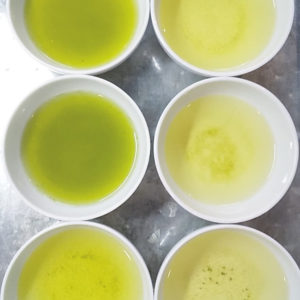
The steaming process is crucial because it stops the oxidation of the tea leaves. That’s how most Japanese green teas are made.
Different lengths of steaming time make notable changes in the resulting sencha.
In general, we have asamushi sencha (浅蒸し煎茶, lightly steamed sencha, about 20 to 30 seconds), futsūmushi (普通蒸し) or chūmushi (中蒸し) sencha with has a normal steaming time, about 30 to 40 seconds, and fukamushi sencha (深蒸し煎茶, greater than 40 seconds).
Let’s see what changes along the steaming time.
Color of the liquor
This is probably the most apparent change.
You might have noticed that once served, fukamushi sencha has a deep green color.
On the other hand, asamushi sencha has clear liquor with a light color.
Leaf appearance
The most intact leaves are achieved with light steaming.
As the steaming time increases, the leaves become more fragile. That’s why a fukamushi sencha easily ends up with a lot of broken bits of leaves.
Aroma
The aroma of asamushi sencha is more intense, especially the fresh aroma.
The longer the steaming time, the weaker the aroma becomes.
Taste
In a deep steamed tea, astringency is lowered and more body can be felt.
This happens because at higher steaming times the pectin content increases.
For asamushi sencha, the higher astringency also results is a more refreshing taste.
Conclusion
Each type has advantages and disadvantages.
Some specific cultivars in specific regions are better suited for one type of sencha.
I have tasted many excellent teas of each type.
